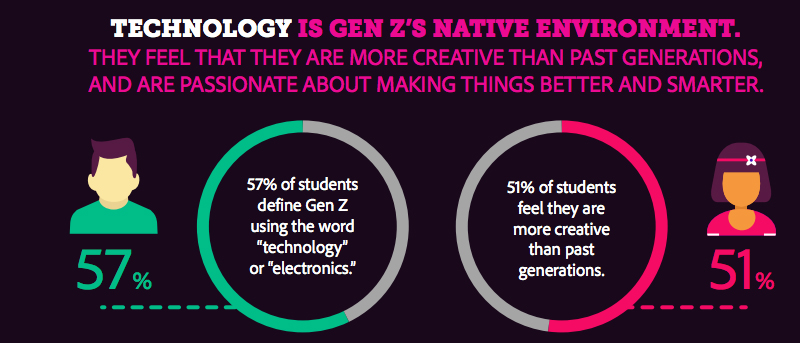3 Ways Tech Can Help Expand Creativity in Higher Ed
For the next generation of college students — or Generation Z — technology has been a part of life since birth. It’s no surprise that 93 percent of these students said in an Adobe Education survey that technology in the classroom was essential for their career preparedness. Eighty-nine percent also believe that creativity will play a big part of their future success.
Among the survey’s major insights: “Gen Z students see tech and creativity as important and intersecting aspects of their identities.”
Some higher education institutions — like Parsons School of Design, Clemson University and Rochester Institute of Technology — are already prepared for the intersecting needs of Gen Z students, with programs that combine creativity and technology.

SOURCE: Adobe, "Gen Z in the Classroom: Creating the Future"
1. Engineering Processes Help Designers Innovate
Parsons School of Design in New York has already begun to reach out to some Gen Z students through a partnership called Creative Technology, where Parsons staff show students at New Vision Charter High School how technology can help with problem solving in art and design, The New School News reports.
Noelia Bautista, who made a music box that could communicate with a computer using the Arduino open-source computing platform, told The New School News that the experience not only inspired her to study to be an interior designer, but also gave her a newfound appreciation for using tech creatively.
As the article describes, though technology and interior design seem quite different, “by engaging in the iterative design process, as well as user testing, sketching, and prototyping, Bautista was able to cultivate the creative skills needed to tackle a wide range of design challenges.”
2. Tech-Filled Spaces Encourage New Ideas and Collaboration
Through a one-of-a-kind partnership with Adobe, Clemson University opened a digital studio in their library to “serve as a teaching, training and collaborative environment to support next-generation learning and creativity,” according to a news release.
The Adobe Digital Studio, which opened in 2014, is an open-access learning space with workstations outfitted with Adobe Creative Cloud, as well as audiovisual recording studios and a Creativity Bar where Adobe interns can help students brainstorm.
According to the studio’s website, the space is adaptable to give students access to digital tools, “in order to guarantee their success both in the classroom and on the job market,” and the freedom to work collaboratively.
“As humanities students, we haven’t had the same opportunities as STEM students with regard to cutting-edge learning technologies,” former student Katie Flessas says in the news release. “With access to Adobe Creative Cloud, we’re leveling the playing field.”
3. Tech Creates Entirely New Artistic Experiences
Rochester Institute of Technology, which has been an innovator in digital gaming, announced the launch of their new MAGIC Spell Studios, a high-tech 43,000-square-foot building that will support academic programs in game development, film and animation and other digital media, a University News story reports.
“The ways people engage with games and interactive content are changing more rapidly than ever before and the industry is more multi-faceted than ever as it continues to define itself,” says David Schwartz, the direct of RIT’s school of interactive games and media, in the article. “We have to challenge what our students build for these new horizons.”
The studios will house a sound stage, theater, AV system and several labs and production facilities, all with the hope that students can work together creatively to launch their own startups.








